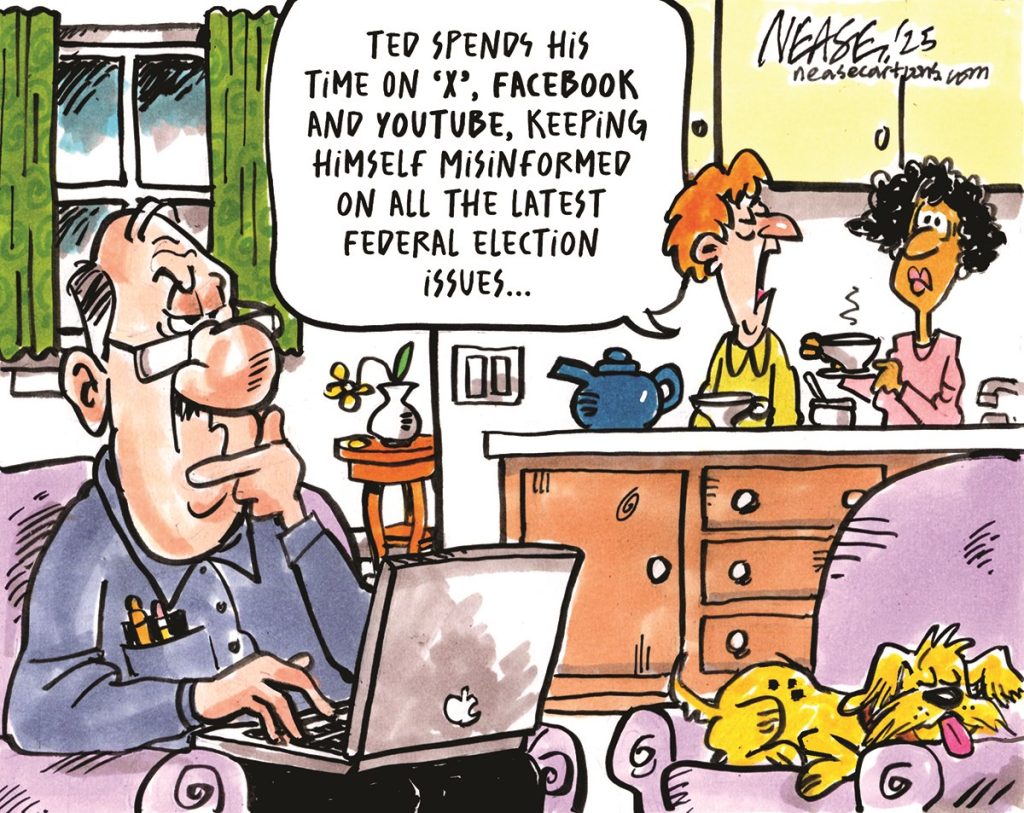The Deluge of Deceit: Navigating the Treacherous Waters of Misinformation
The digital age, with its unprecedented access to information, has inadvertently ushered in a new era of manipulation and deceit. A recent political cartoon, published in the Niagara-on-the-Lake Local, vividly captures this contemporary struggle. It depicts individuals adrift on flimsy rafts in a turbulent sea of misinformation, desperately clinging to fragments of truth while being bombarded by a relentless downpour of falsehoods. This powerful image serves as a stark reminder of the precarious nature of knowledge in our current information ecosystem, a landscape increasingly dominated by the rapid spread of misleading and fabricated content. The cartoon highlights the urgency with which we must confront this growing threat, emphasizing the individual and collective responsibility to navigate these treacherous waters with discernment and critical thinking.
The proliferation of misinformation poses a multifaceted challenge to individuals and democratic societies alike. From influencing political discourse and eroding public trust in institutions to fueling social divisions and inciting violence, the consequences of unchecked misinformation can be devastating. The cartoon’s depiction of a chaotic and overwhelming flood underscores the sense of helplessness that many feel in the face of this constant barrage of false and misleading information. The fragmented rafts symbolize the precarious grasp individuals have on verifiable facts, constantly threatened by the swirling currents of manipulated narratives and outright lies. The visual metaphor effectively portrays the vulnerability of individuals in this digital landscape, struggling to stay afloat amidst a deluge of deceit.
The ease with which misinformation spreads online is a significant contributing factor to this crisis. Social media platforms, while offering unprecedented opportunities for connection and communication, have also become fertile ground for the dissemination of false narratives. Algorithms designed to maximize engagement often prioritize sensational and emotionally charged content, regardless of its veracity. This creates a feedback loop where misinformation spreads rapidly, amplified by echo chambers and filter bubbles that reinforce pre-existing biases. The cartoon’s depiction of a torrential downpour suggests the overwhelming volume of misinformation circulating online, constantly bombarding individuals with conflicting and often contradictory information. This constant exposure makes it increasingly difficult for individuals to distinguish between credible sources and purveyors of falsehoods.
The responsibility for combating misinformation rests not solely on individuals but also on the platforms that facilitate its spread. Social media companies have a crucial role to play in implementing robust fact-checking mechanisms, promoting media literacy, and curbing the spread of harmful content. While some progress has been made in recent years, including the labeling of potentially misleading information and the removal of accounts promoting demonstrably false narratives, much more needs to be done. The cartoon’s focus on individual struggle highlights the inadequacy of relying solely on individual vigilance. A comprehensive approach requires a collaborative effort involving platform accountability, government regulation, and educational initiatives aimed at equipping individuals with the critical thinking skills necessary to navigate the complex digital landscape.
Beyond the realm of social media, traditional news outlets also bear a responsibility to uphold journalistic integrity and combat the spread of misinformation. Investigative journalism plays a vital role in exposing false narratives and holding those who propagate them accountable. Furthermore, media organizations must prioritize accuracy and fairness in their reporting, providing context and avoiding sensationalism that can inadvertently contribute to the spread of misinformation. The cartoon’s depiction of individuals clinging to fragmented rafts underscores the importance of reliable and trustworthy sources of information. In a sea of misinformation, credible news outlets serve as anchors, providing a foundation of factual reporting that individuals can rely upon to make informed decisions.
Ultimately, combating the deluge of misinformation requires a collective effort from individuals, platforms, governments, and educational institutions. Promoting media literacy is crucial, empowering individuals with the critical thinking skills necessary to evaluate information sources, identify bias, and distinguish between fact and fiction. This includes fostering a healthy skepticism towards information encountered online, verifying information from multiple sources, and being mindful of the potential for manipulation. The cartoon’s powerful imagery serves as a call to action, urging us to navigate the treacherous waters of misinformation with vigilance, critical thinking, and a shared commitment to upholding the truth. Just as the individuals in the cartoon are depicted struggling to stay afloat, so too must we actively strive to navigate the digital landscape with discernment, seeking out reliable sources of information and resisting the seductive allure of misinformation. Only through collective action and a commitment to truth can we hope to stem the tide of deceit and reclaim the integrity of our information ecosystem.


